Tribes Call the Canyon Home
Native Americans and National Parks
About
The Journey
Sequoia National Park
Ranked the 7th most popular national park in the US, Sequoia is filled with natural and Native American history. The park is also part of the southern Sierra which is and was home to tribes such as the Miwok , Yokut, Tübatulabal, Paiute, and Monache. All of these tribes had completely separate identities and customs but worked together to preserve the land to the best of their ability.
Yosemite National Park
Yosemite National Park is known as home to several tribes among California such as the Mono, Miwuk, Chukchansi, Paiute, Kootzaduka'a, Me-wuk, and Paiute-Shoshone people. Though it is federally protected as a national park, native traditions still hold to this day in order to maintain the well-being of the area. Natives continue to live nearby and utilize resources for basketweaving which is a highly culturally significant activity of the associated Yosemite tribes.
Arches National Park
Arches National Park territory first belonged to the Ute and Navajo tribes. The Navajo occupied the border but never used many resources from the overall park. The Ute and Paiute tribes from the Shoshonean peoples hunted and gathered throughout the parks territory. From what petroglyphs depict, the Ute people would hunt on horseback and big horned sheep for agricultural purposes.
Red Rock Canyon
Red Rock Canyon was known to be home for the Kawaiisu Natives who occupied the western edge of the El Paso mountain edge. It existed as a Native American trade route. The Red Rock Canyon of Las Vegas, Nevada was also home to the tribes of Southern Paiute Indians, Virgin Anasazi Indians, Desert Archaic peoples, and Paleoarchaic peoples. They were drawn to the abundant resources such as plants and animals, making it a suitable place to settle.
The Grand Canyon
Being the fourth most visited national park in the U.S, The Grand Canyon is rich with Native American history. From trail markings to paintings on the crystal cave walls, The Grand Canyon carries on the history of its Native inhabitants from the past thousands of years. Each path in the Grand Canyon leads the way to a fellow associated tribe of the Grand Canyon. When you arrive there is a stone plaque in the ground indicating "The Tribes that Call the Canyon Home" and which direction they lived in.
Sources
“Ahwahnechee.” Wikipedia, 16 Oct. 2022, en.wikipedia.org/wiki/Ahwahnechee Accessed 12 Jan. 2023.
“American Indian History | OAH.” Www.oah.org, www.oah.org/lectures/featured/american-indian/? gclid=Cj0KCQjwkt6aBhDKARIsAAyeLJ3WsiXg0678_88eZTHHWqc7TKGcdmwyfqOCrHc_0M41q7IRlZO-qFIaAru9EALw_wcB. Accessed 12 Jan. 2023.
American Indians and National Parks. www.culturalsurvival.org/publications/cultural-survival-quarterly/american-indians-and-national-parks gclid=Cj0KCQjwkt6aBhDKARIsAAyeLJ3XQu7d4QhsPjpAXMvpVCGfiNUz2bAcvU7UhbippiZbziR7K06q_qUaAnYoEALw_wcB. Accessed 12 Jan. 2023.
“Associated Tribes - Grand Canyon National Park (U.S. National Park Service).” Www.nps.gov, www.nps.gov/grca/learn/historyculture/associated-tribes.htm.
Biggs, Patricia. “Havasupai – Nature, Culture and History at the Grand Canyon.” Grcahistory.org, grcahistory.org/history/native-cultures/havasupai/.
Boulder Dam and the Navajo Reservation | Native American Netroots. nativeamericannetroots.net/diary/1761#:~:text=The%20case%20of%20Boulder%20Dam. Accessed 7 Oct. 2020.
Castillo, Edward D. “California Indian History – California Native American Heritage Commission.” Ca.gov, 2022, nahc.ca.gov/resources/california-indian-history/.
Cattanach, Jamie. “The Indigenous History of Sequoia National Park.” RVshare, 6 Jan. 2022, rvshare.com/blog/the-indigenous-history-of-sequoia-national-park/. Accessed 12 Jan. 2023.
Chris. “The Largest US & Canadian National Parks in North America by Acreage.” Parks & Trips, 11 Feb. 2022, parksandtrips.com/largest-national-parks/. Accessed 12 Jan. 2023.
Duncan, Dayton. “Yosemite National Park Was Created 150 Years Ago.” Earth Island Journal, 30 June 2014, www.earthisland.org/journal/index.php/articles/entry/yosemite_national_park_was_created_150_years_ago/?utm_source=google&utm_medium=paid&utm_campaign=tfd_dsa&gclid=Cj0KCQjwkt6aBhDKARIsAAyeLJ2GgrljLCGl_tdKF8y3WLDSo4u7eBi8D_Co6QrgCDRjwcRGsb4uBbcaAvUmEALw_wcB. Accessed 12 Jan. 2023.
“Exploring Tribal Connections to Arches National Park (U.S. National Park Service).” Www.nps.gov, 31 Jan. 2019, www.nps.gov/articles/arch-eoa.htm.
Green, Tyler. “Devoted Forever to Popular Resort and Recreation.” Places Journal, no. 2017, 5 Dec. 2017, 10.22269/171205. Accessed 27 July 2019.
“Indian Village of the Ahwahnee - Yosemite National Park (U.S. National Park Service).” Www.nps.gov, 27 Sept. 2021, www.nps.gov/yose/learn/historyculture/indian-village-of-the-ahwahnee.htm.
“Position on H.R. 538 Native American Energy Act.” National Parks Conservation Association, 7 Aug. 2015, www.npca.org/articles/831-position-on-h-r-538-native-american-energy-act. Accessed 12 Jan. 2023.
“Red Rock Canyon a to Z: N Is for Native Americans.” Red Rock Canyon Las Vegas, www.redrockcanyonlv.org/red-rock-canyon-a-to-z-nativeamericans/. Accessed 12 Jan. 2023.
Siyuja, Thomas. Havasupai Tribe. 7 June 2022.
“Their Lifeways - Yosemite National Park (U.S. National Park Service).” Www.nps.gov, 21 Nov. 2021, www.nps.gov/yose/learn/historyculture/their-lifeways.htm.
Wadzinski, Gloria. “Native Americans throughout Time in the Grand Canyon.” Grand Canyon National Park Trips, 24 Feb. 2010, www.mygrandcanyonpark.com/park/history/grand-canyon-native-american-history/.
“Who Were the Natives of Red Rock Canyon?” Red Rock Canyon Las Vegas, www.redrockcanyonlv.org/who-were-the-natives-of-red-rock-canyon/. Accessed 12 Jan. 2023.
“Yellowstone’s Native Fisheries: Opportunities for Native Fish Conservation & Restoration.” National Parks Conservation Association, 10 Nov. 2011, www.npca.org/resources/2385-yellowstone-s-native-fisheries-opportunities-for-native-fish-conservation. Accessed 12 Jan. 2023.
“Yosemite’s First Stewards.” Yosemite Conservancy, 5 Nov. 2021, yosemite.org/news/yosemites-first-stewards/?gclid=Cj0KCQjwqoibBhDUARIsAH2OpWiyiw7YE6QCwPDENNsW-OUq7s1cWG5LfPy-RBpIkXtCwwwXSNw-9nQaAvyMEALw_wcB. Accessed 12 Jan. 2023.























































